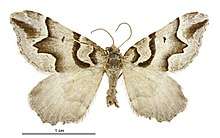Helastia expolita
Helastia expolita is a moth of the family Geometridae. This species is endemic to New Zealand. It is classified as "At Risk, Relict'" by the Department of Conservation.
| Helastia expolita | |
|---|---|
 | |
| Male | |
| Scientific classification | |
| Kingdom: | Animalia |
| Phylum: | Arthropoda |
| Class: | Insecta |
| Order: | Lepidoptera |
| Family: | Geometridae |
| Genus: | Helastia |
| Species: | H. expolita |
| Binomial name | |
| Helastia expolita | |
| Synonyms[2] | |
| |
Taxonomy
This species was first described by Alfred Philpott in 1917 using a specimen collected by J.H. Lewis at Broken River, Canterbury and named Hydriomena expolita.[3][4] George Hudson discussed and illustrated this species in his 1928 book The Butterflies and Moths of New Zealand under the same name.[5] In 1987 Robin C. Craw placed this species within the genus Helastia.[2] The holotype specimen is held at the New Zealand Arthropod Collection.[4]
Description
Philpott described the species as follows:
♂︎. 30 mm. Head, palpi, and antennae purplish-grey. Thorax fuscous-brown mixed with grey. Abdomen fuscous-grey with some reddish scales laterally. Forewings moderate, triangular, costa moderately arched, apex subacute, termen sinuate, oblique ; whitish-grey with faint purplish tinge ; markings dark purplish-fuscous ; basal line thick, evenly curved, projecting angularly at middle ; anterior margin of median band inwardly oblique beneath costa at 1⁄3, thence broadly excurved to dorsum at 1⁄4 ; posterior margin from 2⁄3 costa to 3⁄4 dorsum, with strong broad apically-indented projection at middle ; traces of a thin waved white subterminal line ; an oblique suffused purplish-fuscous fascia from apex : cilia grey, obscurely barred with fuscous, tips whitish. Hindwings elongate, termen angularly projecting at middle ; purplish-grey ; basal half darker, being marked off by a median fascia parallel to termen : cilia as in forewings. Undersides : Forewings ochreous-reddish with the upper markings faintly reproduced ; hindwings ochreous-reddish, terminal half suffused with whitish.[3]
Distribution
This species is endemic to New Zealand.[6][1] It occurs in Buller, Marlborough, North Canterbury and Mid Canterbury.[2]
Biology and lifecycle
Very little is known about the biology of H. expolita.[7]
Host species and habitat
This species prefers short tussock grassland habitat in montane to subalpine zones.[2][8] The host species for the larvae of H. expolita is unknown.[9] It has been hypothesised the larvae of H. expolita feed on the flowers of Helichrysum species and then feed on mosses, lichens or shrubs growing nearby.[10]
Conservation status
This moth is classified under the New Zealand Threat Classification system as being "At Risk, Relict".[11] The decline in the area and quality of this species habitat is one of the factors putting this species at risk.[7]
References
| Wikimedia Commons has media related to Helastia expolita. |
- "Helastia expolita (Philpott, 1917)". www.nzor.org.nz. Landcare Research New Zealand Ltd. Retrieved 2018-05-16.
- Craw, R. C. (1987). "Revision of the genus Helastia sensu stricto with description of a new genus (Lepidoptera: Geometridae: Larentiinae)". New Zealand Journal of Zoology. 14 (2): 269–293. doi:10.1080/03014223.1987.10422997.
- Philpott, A. (1917). "Descriptions of new species of Lepidoptera". Transactions and Proceedings of the New Zealand Institute. 49: 239–245. Retrieved 16 May 2018.
- Dugdale, J. S. (1988). "Lepidoptera - annotated catalogue, and keys to family-group taxa" (PDF). Fauna of New Zealand. 14: 181. Retrieved 16 May 2018.
- Hudson, G. V. (1928). The Butterflies and Moths of New Zealand. Wellington: Ferguson & Osborn Ltd. p. 98.
- Gordon, Dennis P., ed. (2010). New Zealand Inventory of Biodiversity, Volume Two, Kingdom Animalia: Chaetognatha, Ecdysozoa, Ichnofossils. Vol. 2. Christchurch, N.Z.: Canterbury University Press. p. 459. ISBN 9781877257933. OCLC 973607714.
- Pawson, S.M.; Emberson, R.M. (2000). "The conservation status of invertebrates in Canterbury" (PDF). Conservation Advisory Science Notes. 320: 1–64.
- Pawson, S.M.; Emberson, R.M. (2000). "The conservation status of invertebrates in Canterbury" (PDF). Conservation Advisory Science Notes. 320: 1–64.
- Patrick, Brian; Dugdale, John S. (2000). Conservation status of the New Zealand lepidoptera (PDF). Wellington, N.Z.: Department of Conservation, New Zealand. p. 24. ISBN 978-0478218671. OCLC 154670803.
- Patrick, Brian (2014). "Of lichens and mosses" (PDF). Butterflies and Moths of New Zealand. 11: 8.
- Hoare, R.J.B.; Dugdale, J.S.; Edwards, E.D.; Gibbs, G.W.; Patrick, B.H.; Hitchmough, R.A.; Rolfe, J.R. (2017). Conservation status of New Zealand butterflies and moths (Lepidoptera), 2015 (PDF). Wellington, New Zealand: New Zealand Department of Conservation. p. 7. ISBN 9781988514383.